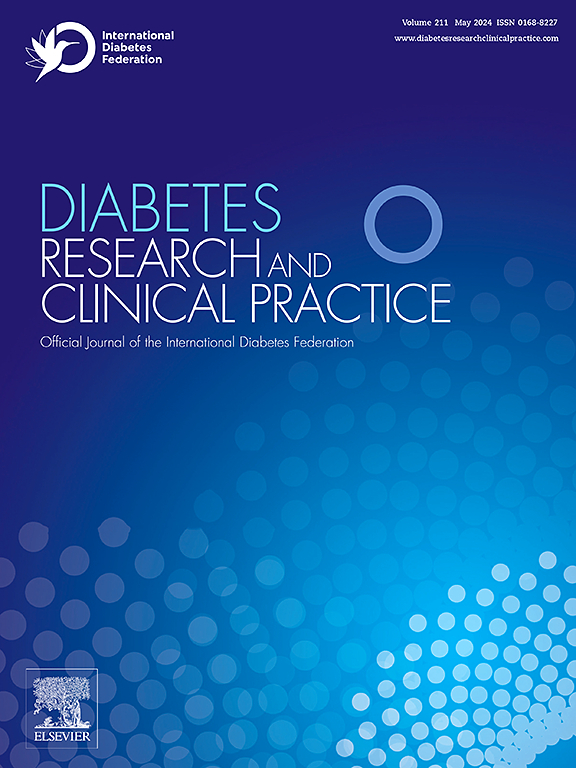加拿大2型糖尿病移民和长期居民中糖尿病肾病的世界出生地区患病率
IF 6.1
3区 医学
Q1 ENDOCRINOLOGY & METABOLISM
引用次数: 0
摘要
目的:了解移民和长期居住的2型糖尿病(T2D)患者中糖尿病肾病(DKD)的患病率。方法:我们在加拿大安大略省进行了一项基于人群的回顾性队列研究,研究对象为年龄在20-79 岁的T2D成年人。暴露对象为世界出生地区(移民);长期居民为对照组。结果是DKD,由肾脏疾病:改善全球结局(KDIGO)类别定义。我们测量了年龄-性别标准化的DKD患病率,并构建了逻辑回归模型来计算校正优势比(OR),估计暴露与结果之间的关联。结果:我们纳入了210,693名移民(平均年龄59.8[标准差10.8]岁,男性54.3 %)和539,632名长期居民(平均年龄64.1[10.4]岁,男性56.1% %)。出生在东亚的移民KDIGO低风险类别的患病率和调整后的几率最高(76.6% %,OR 1.59, 1.53-1.64)。东南亚出生的移民KDIGO低风险类别的患病率最低(64.0 %),中等增加、高风险和极高风险KDIGO类别的患病率和调整后的几率最高(OR: 1.21, [1.18-1.25];1.20, 1.14 - -1.26;1.18, 1.12-1.25)。结论:移民中DKD的患病率根据世界出生地区有很大差异。本文章由计算机程序翻译,如有差异,请以英文原文为准。
Prevalence of diabetic kidney disease by world region of birth among immigrants and long-term residents of Canada with type 2 diabetes
Aims
To measure the prevalence of diabetic kidney disease (DKD) among immigrants and long-term residents with type 2 diabetes (T2D).
Methods
We conducted a population-based retrospective cohort study in Ontario, Canada among adults aged 20–79 years with T2D. The exposure was world region of birth (immigrants); long-term residents were the comparison group. The outcome was DKD, defined by the Kidney Disease: Improving Global Outcomes (KDIGO) categories. We measured the age-sex standardized prevalence of DKD and constructed logistic regression models to compute adjusted odds ratios (OR) estimating the association between the exposure and outcome.
Results
We included 210,693 immigrants (mean age 59.8 [standard deviation 10.8] years, 54.3 % male) and 539,632 long-term residents (mean age 64.1 [10.4] years, 56.1 % male). Immigrants born in East Asia had the highest prevalence and adjusted odds of the KDIGO low-risk category (76.6 %, OR 1.59, 1.53–1.64). Immigrants born in Southeast Asia had the lowest prevalence of the KDIGO low-risk category (64.0 %), and the highest prevalence and adjusted odds of the moderately-increased, high, and very-high risk KDIGO categories (OR: 1.21, [1.18–1.25]; 1.20, 1.14–1.26; 1.18, 1.12–1.25) compared to long-term residents.
Conclusions
There is substantial variation in the prevalence of DKD among immigrants according to world region of birth.
求助全文
通过发布文献求助,成功后即可免费获取论文全文。
去求助
来源期刊

Diabetes research and clinical practice
医学-内分泌学与代谢
CiteScore
10.30
自引率
3.90%
发文量
862
审稿时长
32 days
期刊介绍:
Diabetes Research and Clinical Practice is an international journal for health-care providers and clinically oriented researchers that publishes high-quality original research articles and expert reviews in diabetes and related areas. The role of the journal is to provide a venue for dissemination of knowledge and discussion of topics related to diabetes clinical research and patient care. Topics of focus include translational science, genetics, immunology, nutrition, psychosocial research, epidemiology, prevention, socio-economic research, complications, new treatments, technologies and therapy.
 求助内容:
求助内容: 应助结果提醒方式:
应助结果提醒方式:


